Zara: Business Level Strategy, Generic Strategies, and Market Analysis
VerifiedAdded on 2023/04/24
|18
|4654
|376
Report
AI Summary
This report provides a comprehensive strategic analysis of Zara, a leading international fashion retail brand. It begins with an executive summary highlighting Zara's success in the high street fashion industry, driven by its strong supply chain and innovative market products. The report then delves into an external business environment analysis using PESTLE and Porter's Five Forces, examining political, economic, social, technological, legal, and environmental factors, as well as competitive forces within the industry. An internal organizational analysis, including a SWOT analysis, identifies Zara's strengths, weaknesses, opportunities, and threats. Furthermore, the report explores Zara's resource-based view and value chain, focusing on design, sourcing, production, logistics, marketing, and infrastructure. The report also addresses potential crises, such as environmental concerns and human rights issues, and concludes with strategic recommendations for future endeavors.
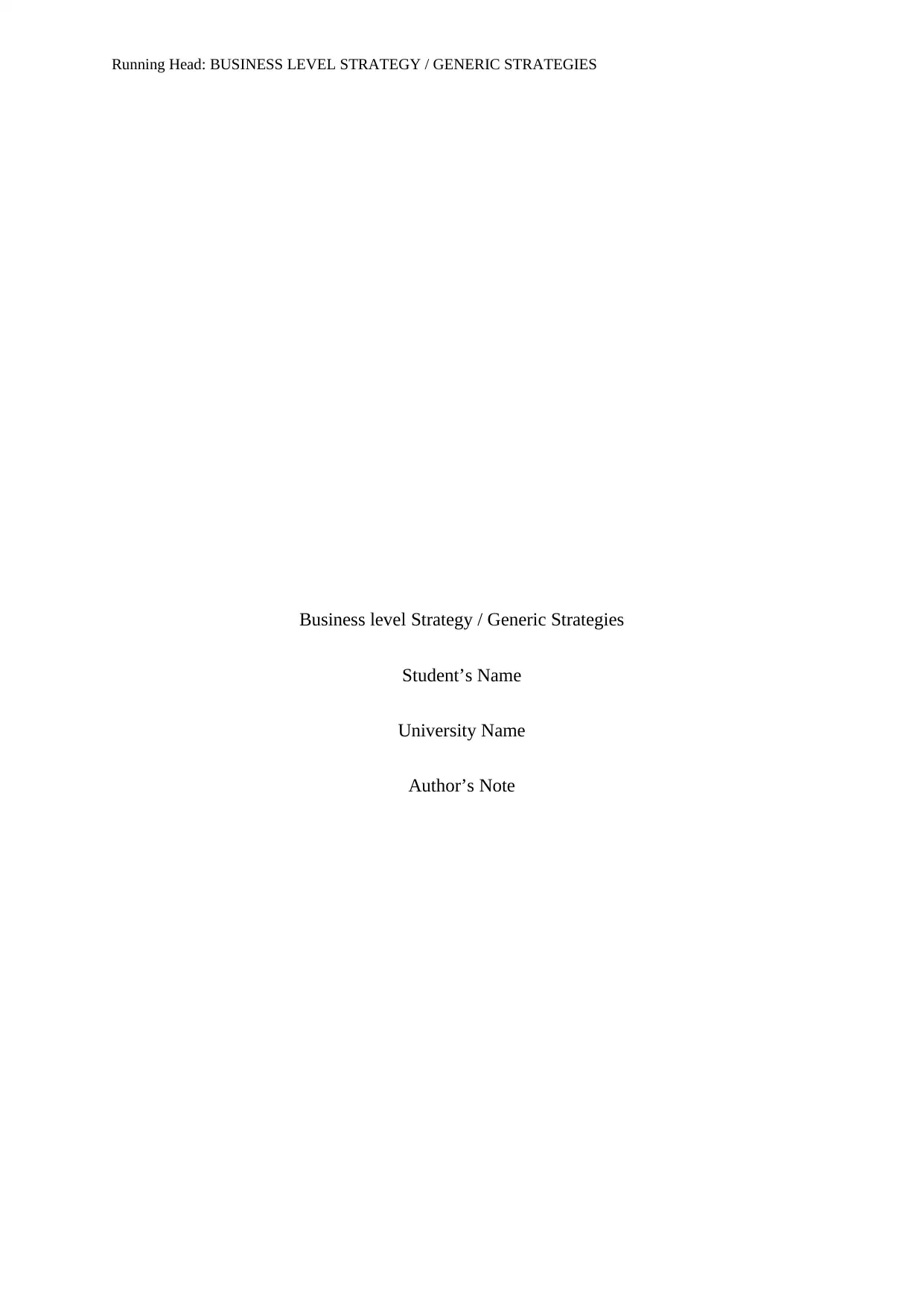
Running Head: BUSINESS LEVEL STRATEGY / GENERIC STRATEGIES
Business level Strategy / Generic Strategies
Student’s Name
University Name
Author’s Note
Business level Strategy / Generic Strategies
Student’s Name
University Name
Author’s Note
Paraphrase This Document
Need a fresh take? Get an instant paraphrase of this document with our AI Paraphraser
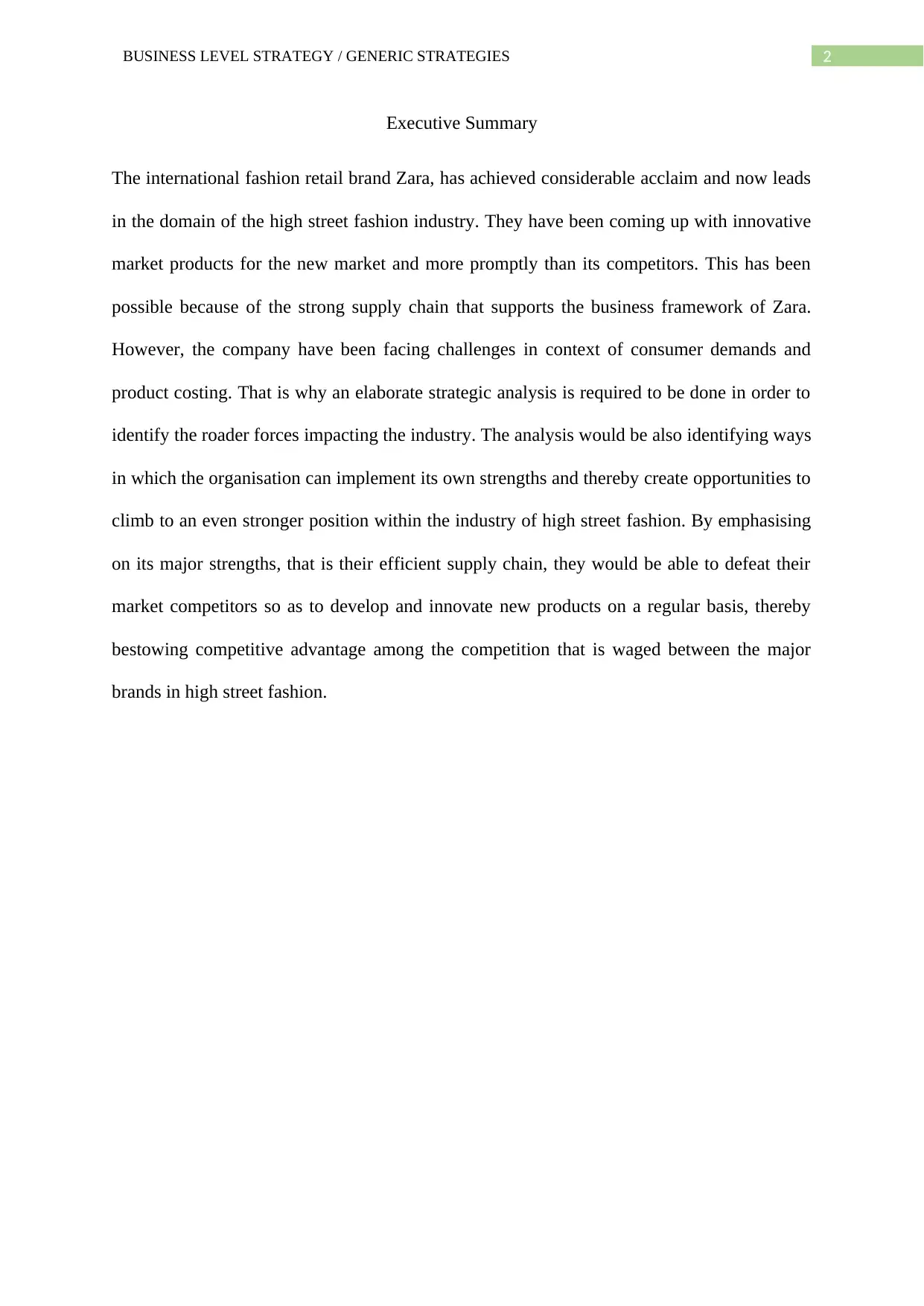
2BUSINESS LEVEL STRATEGY / GENERIC STRATEGIES
Executive Summary
The international fashion retail brand Zara, has achieved considerable acclaim and now leads
in the domain of the high street fashion industry. They have been coming up with innovative
market products for the new market and more promptly than its competitors. This has been
possible because of the strong supply chain that supports the business framework of Zara.
However, the company have been facing challenges in context of consumer demands and
product costing. That is why an elaborate strategic analysis is required to be done in order to
identify the roader forces impacting the industry. The analysis would be also identifying ways
in which the organisation can implement its own strengths and thereby create opportunities to
climb to an even stronger position within the industry of high street fashion. By emphasising
on its major strengths, that is their efficient supply chain, they would be able to defeat their
market competitors so as to develop and innovate new products on a regular basis, thereby
bestowing competitive advantage among the competition that is waged between the major
brands in high street fashion.
Executive Summary
The international fashion retail brand Zara, has achieved considerable acclaim and now leads
in the domain of the high street fashion industry. They have been coming up with innovative
market products for the new market and more promptly than its competitors. This has been
possible because of the strong supply chain that supports the business framework of Zara.
However, the company have been facing challenges in context of consumer demands and
product costing. That is why an elaborate strategic analysis is required to be done in order to
identify the roader forces impacting the industry. The analysis would be also identifying ways
in which the organisation can implement its own strengths and thereby create opportunities to
climb to an even stronger position within the industry of high street fashion. By emphasising
on its major strengths, that is their efficient supply chain, they would be able to defeat their
market competitors so as to develop and innovate new products on a regular basis, thereby
bestowing competitive advantage among the competition that is waged between the major
brands in high street fashion.
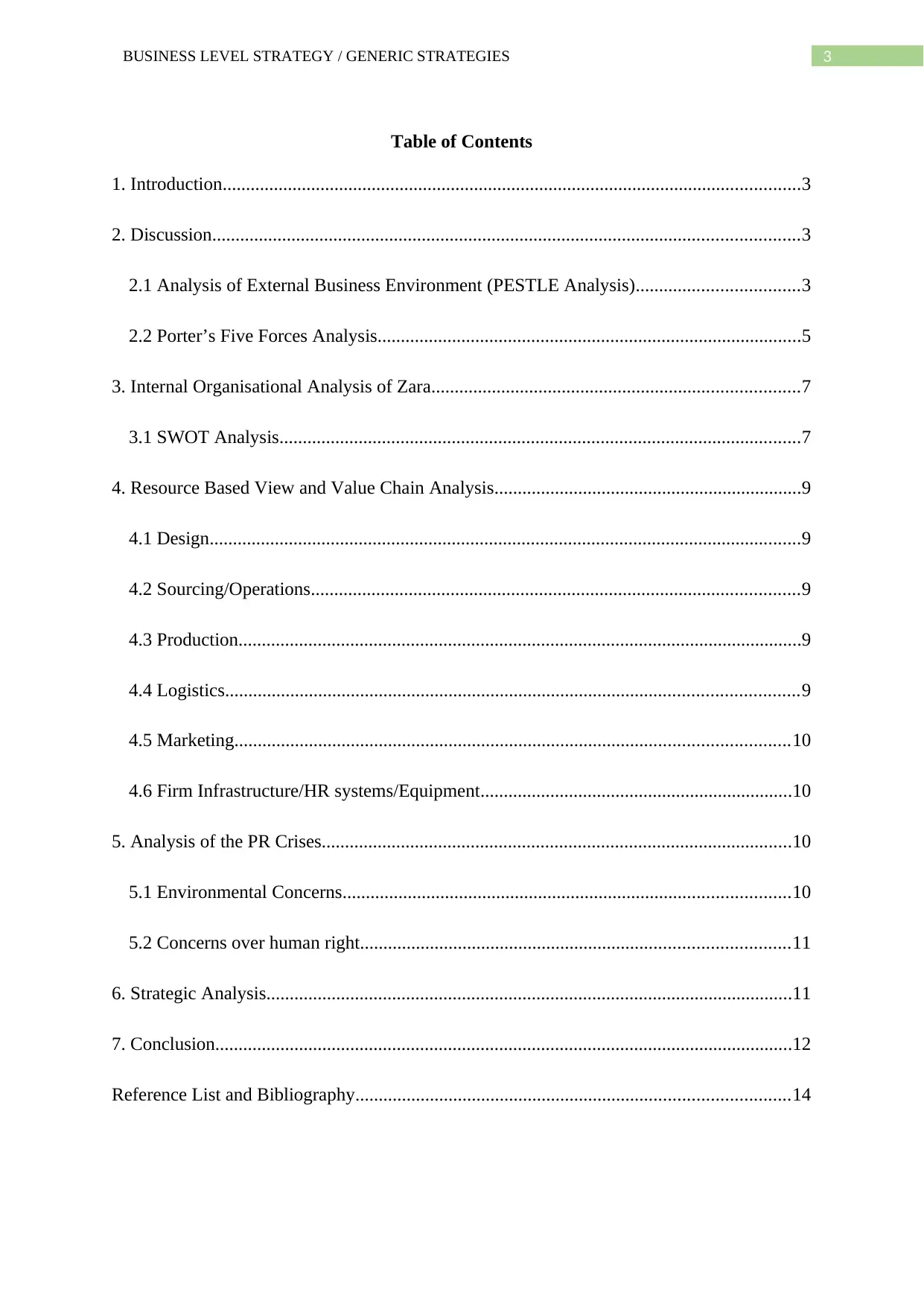
3BUSINESS LEVEL STRATEGY / GENERIC STRATEGIES
Table of Contents
1. Introduction............................................................................................................................3
2. Discussion..............................................................................................................................3
2.1 Analysis of External Business Environment (PESTLE Analysis)...................................3
2.2 Porter’s Five Forces Analysis...........................................................................................5
3. Internal Organisational Analysis of Zara...............................................................................7
3.1 SWOT Analysis................................................................................................................7
4. Resource Based View and Value Chain Analysis..................................................................9
4.1 Design...............................................................................................................................9
4.2 Sourcing/Operations.........................................................................................................9
4.3 Production.........................................................................................................................9
4.4 Logistics...........................................................................................................................9
4.5 Marketing.......................................................................................................................10
4.6 Firm Infrastructure/HR systems/Equipment...................................................................10
5. Analysis of the PR Crises.....................................................................................................10
5.1 Environmental Concerns................................................................................................10
5.2 Concerns over human right............................................................................................11
6. Strategic Analysis.................................................................................................................11
7. Conclusion............................................................................................................................12
Reference List and Bibliography.............................................................................................14
Table of Contents
1. Introduction............................................................................................................................3
2. Discussion..............................................................................................................................3
2.1 Analysis of External Business Environment (PESTLE Analysis)...................................3
2.2 Porter’s Five Forces Analysis...........................................................................................5
3. Internal Organisational Analysis of Zara...............................................................................7
3.1 SWOT Analysis................................................................................................................7
4. Resource Based View and Value Chain Analysis..................................................................9
4.1 Design...............................................................................................................................9
4.2 Sourcing/Operations.........................................................................................................9
4.3 Production.........................................................................................................................9
4.4 Logistics...........................................................................................................................9
4.5 Marketing.......................................................................................................................10
4.6 Firm Infrastructure/HR systems/Equipment...................................................................10
5. Analysis of the PR Crises.....................................................................................................10
5.1 Environmental Concerns................................................................................................10
5.2 Concerns over human right............................................................................................11
6. Strategic Analysis.................................................................................................................11
7. Conclusion............................................................................................................................12
Reference List and Bibliography.............................................................................................14
⊘ This is a preview!⊘
Do you want full access?
Subscribe today to unlock all pages.

Trusted by 1+ million students worldwide
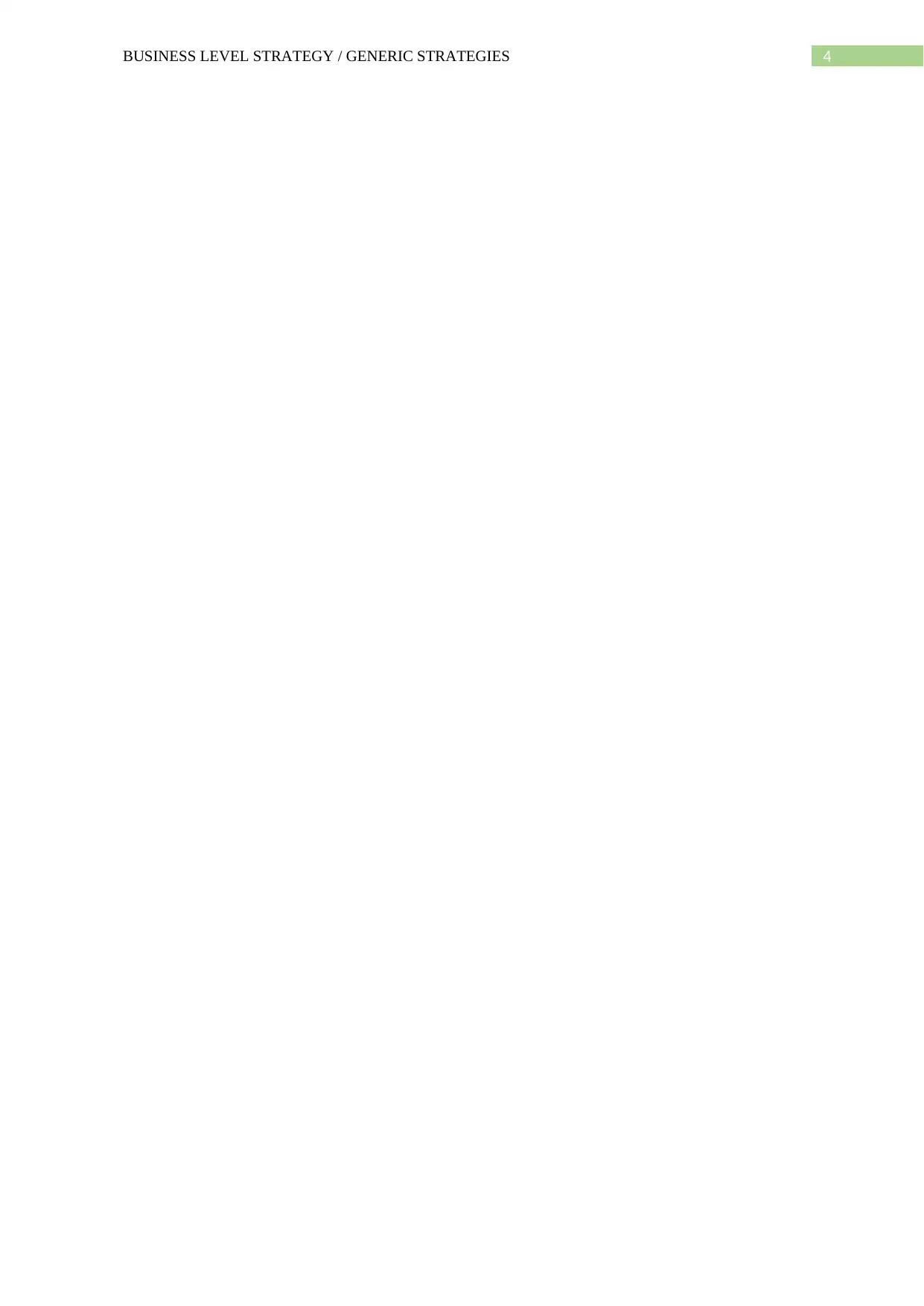
4BUSINESS LEVEL STRATEGY / GENERIC STRATEGIES
Paraphrase This Document
Need a fresh take? Get an instant paraphrase of this document with our AI Paraphraser
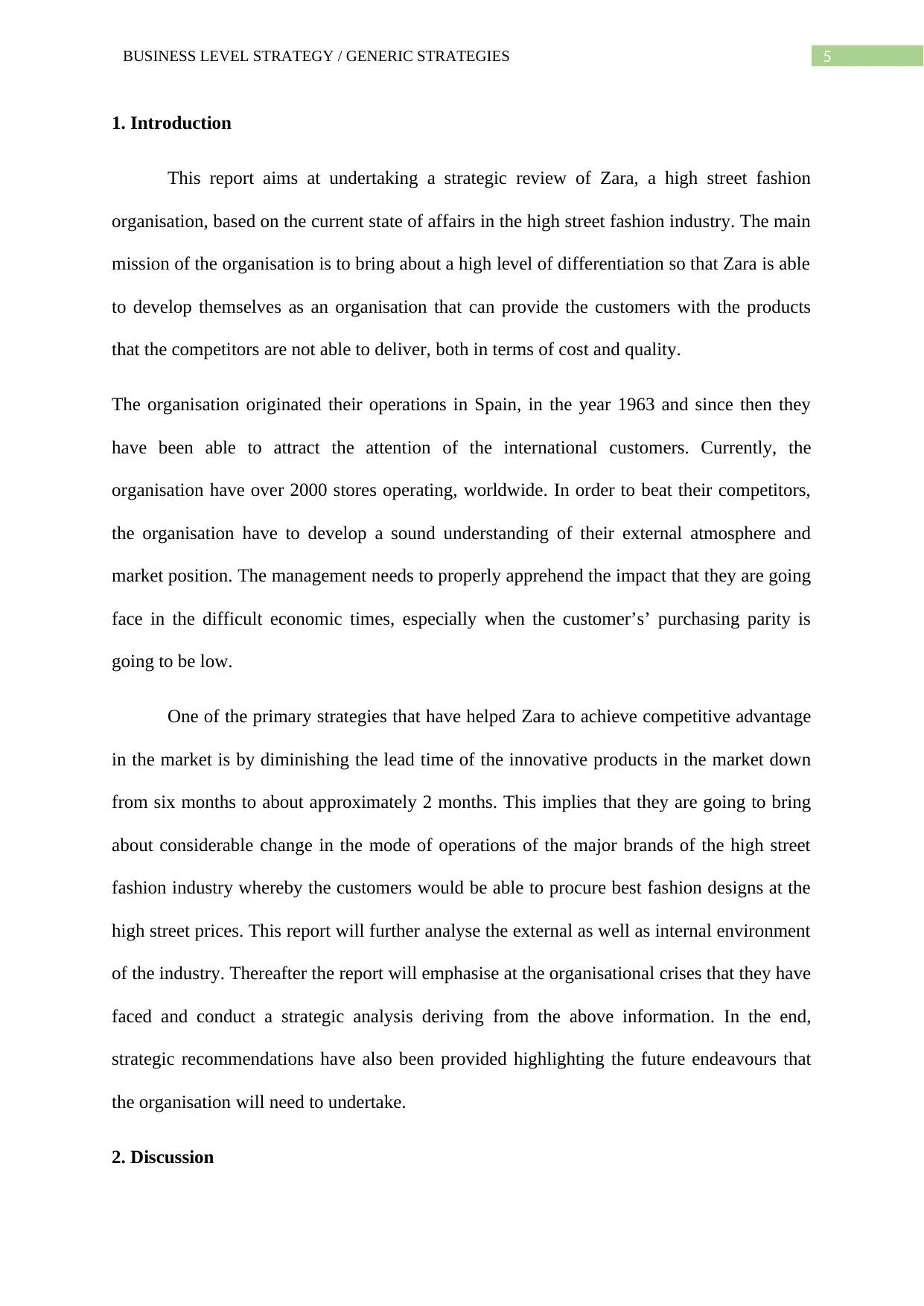
5BUSINESS LEVEL STRATEGY / GENERIC STRATEGIES
1. Introduction
This report aims at undertaking a strategic review of Zara, a high street fashion
organisation, based on the current state of affairs in the high street fashion industry. The main
mission of the organisation is to bring about a high level of differentiation so that Zara is able
to develop themselves as an organisation that can provide the customers with the products
that the competitors are not able to deliver, both in terms of cost and quality.
The organisation originated their operations in Spain, in the year 1963 and since then they
have been able to attract the attention of the international customers. Currently, the
organisation have over 2000 stores operating, worldwide. In order to beat their competitors,
the organisation have to develop a sound understanding of their external atmosphere and
market position. The management needs to properly apprehend the impact that they are going
face in the difficult economic times, especially when the customer’s’ purchasing parity is
going to be low.
One of the primary strategies that have helped Zara to achieve competitive advantage
in the market is by diminishing the lead time of the innovative products in the market down
from six months to about approximately 2 months. This implies that they are going to bring
about considerable change in the mode of operations of the major brands of the high street
fashion industry whereby the customers would be able to procure best fashion designs at the
high street prices. This report will further analyse the external as well as internal environment
of the industry. Thereafter the report will emphasise at the organisational crises that they have
faced and conduct a strategic analysis deriving from the above information. In the end,
strategic recommendations have also been provided highlighting the future endeavours that
the organisation will need to undertake.
2. Discussion
1. Introduction
This report aims at undertaking a strategic review of Zara, a high street fashion
organisation, based on the current state of affairs in the high street fashion industry. The main
mission of the organisation is to bring about a high level of differentiation so that Zara is able
to develop themselves as an organisation that can provide the customers with the products
that the competitors are not able to deliver, both in terms of cost and quality.
The organisation originated their operations in Spain, in the year 1963 and since then they
have been able to attract the attention of the international customers. Currently, the
organisation have over 2000 stores operating, worldwide. In order to beat their competitors,
the organisation have to develop a sound understanding of their external atmosphere and
market position. The management needs to properly apprehend the impact that they are going
face in the difficult economic times, especially when the customer’s’ purchasing parity is
going to be low.
One of the primary strategies that have helped Zara to achieve competitive advantage
in the market is by diminishing the lead time of the innovative products in the market down
from six months to about approximately 2 months. This implies that they are going to bring
about considerable change in the mode of operations of the major brands of the high street
fashion industry whereby the customers would be able to procure best fashion designs at the
high street prices. This report will further analyse the external as well as internal environment
of the industry. Thereafter the report will emphasise at the organisational crises that they have
faced and conduct a strategic analysis deriving from the above information. In the end,
strategic recommendations have also been provided highlighting the future endeavours that
the organisation will need to undertake.
2. Discussion
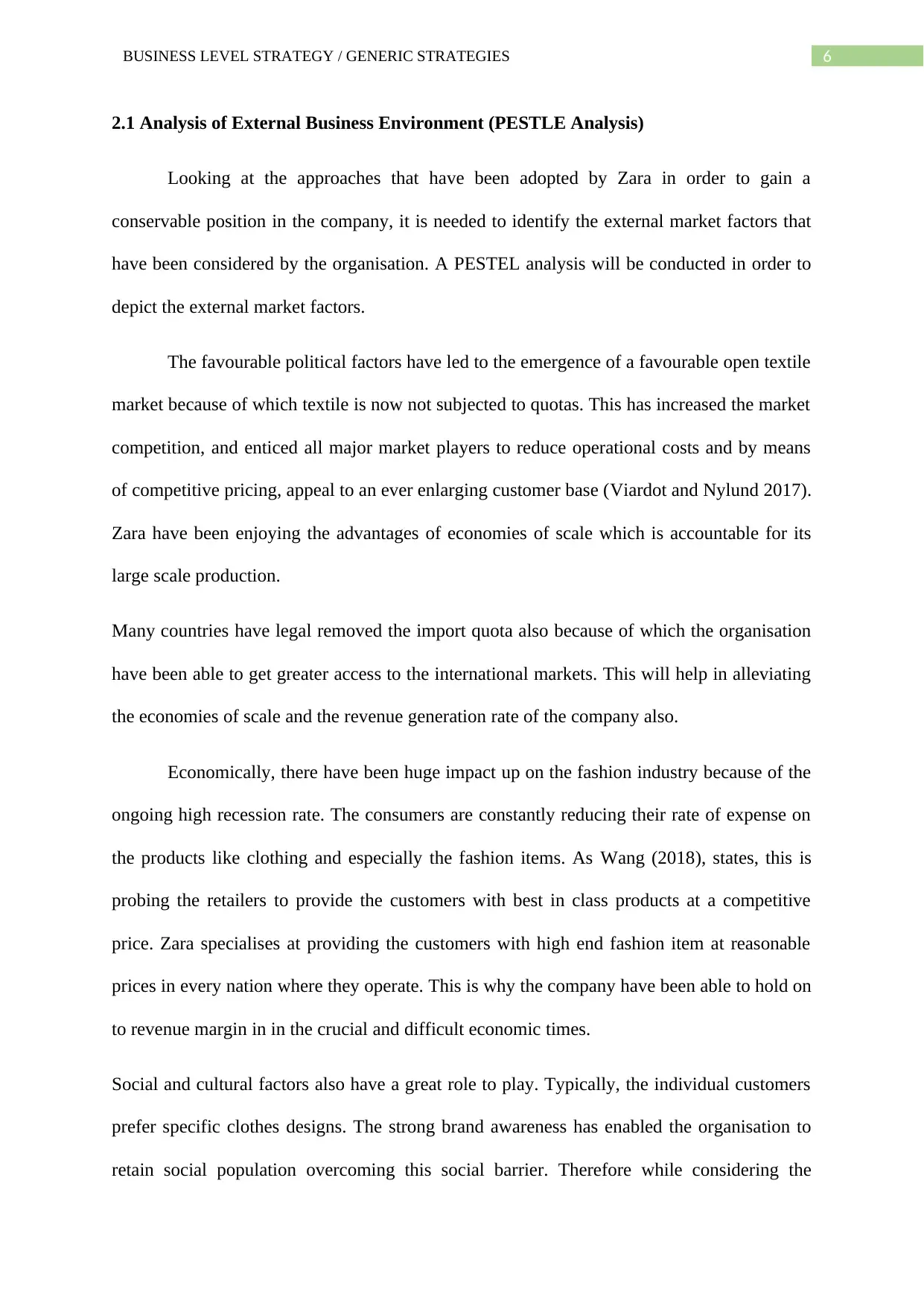
6BUSINESS LEVEL STRATEGY / GENERIC STRATEGIES
2.1 Analysis of External Business Environment (PESTLE Analysis)
Looking at the approaches that have been adopted by Zara in order to gain a
conservable position in the company, it is needed to identify the external market factors that
have been considered by the organisation. A PESTEL analysis will be conducted in order to
depict the external market factors.
The favourable political factors have led to the emergence of a favourable open textile
market because of which textile is now not subjected to quotas. This has increased the market
competition, and enticed all major market players to reduce operational costs and by means
of competitive pricing, appeal to an ever enlarging customer base (Viardot and Nylund 2017).
Zara have been enjoying the advantages of economies of scale which is accountable for its
large scale production.
Many countries have legal removed the import quota also because of which the organisation
have been able to get greater access to the international markets. This will help in alleviating
the economies of scale and the revenue generation rate of the company also.
Economically, there have been huge impact up on the fashion industry because of the
ongoing high recession rate. The consumers are constantly reducing their rate of expense on
the products like clothing and especially the fashion items. As Wang (2018), states, this is
probing the retailers to provide the customers with best in class products at a competitive
price. Zara specialises at providing the customers with high end fashion item at reasonable
prices in every nation where they operate. This is why the company have been able to hold on
to revenue margin in in the crucial and difficult economic times.
Social and cultural factors also have a great role to play. Typically, the individual customers
prefer specific clothes designs. The strong brand awareness has enabled the organisation to
retain social population overcoming this social barrier. Therefore while considering the
2.1 Analysis of External Business Environment (PESTLE Analysis)
Looking at the approaches that have been adopted by Zara in order to gain a
conservable position in the company, it is needed to identify the external market factors that
have been considered by the organisation. A PESTEL analysis will be conducted in order to
depict the external market factors.
The favourable political factors have led to the emergence of a favourable open textile
market because of which textile is now not subjected to quotas. This has increased the market
competition, and enticed all major market players to reduce operational costs and by means
of competitive pricing, appeal to an ever enlarging customer base (Viardot and Nylund 2017).
Zara have been enjoying the advantages of economies of scale which is accountable for its
large scale production.
Many countries have legal removed the import quota also because of which the organisation
have been able to get greater access to the international markets. This will help in alleviating
the economies of scale and the revenue generation rate of the company also.
Economically, there have been huge impact up on the fashion industry because of the
ongoing high recession rate. The consumers are constantly reducing their rate of expense on
the products like clothing and especially the fashion items. As Wang (2018), states, this is
probing the retailers to provide the customers with best in class products at a competitive
price. Zara specialises at providing the customers with high end fashion item at reasonable
prices in every nation where they operate. This is why the company have been able to hold on
to revenue margin in in the crucial and difficult economic times.
Social and cultural factors also have a great role to play. Typically, the individual customers
prefer specific clothes designs. The strong brand awareness has enabled the organisation to
retain social population overcoming this social barrier. Therefore while considering the
⊘ This is a preview!⊘
Do you want full access?
Subscribe today to unlock all pages.

Trusted by 1+ million students worldwide
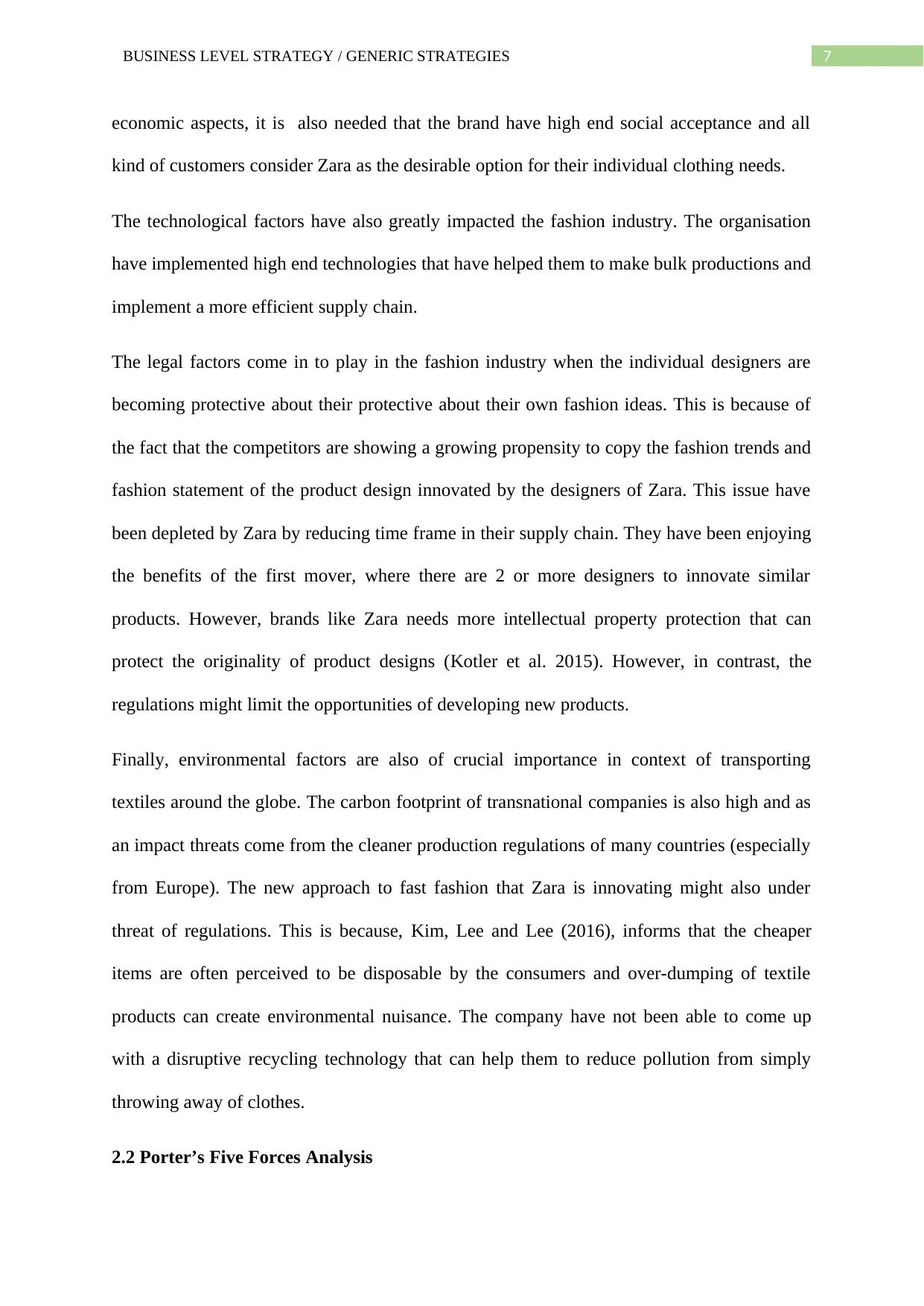
7BUSINESS LEVEL STRATEGY / GENERIC STRATEGIES
economic aspects, it is also needed that the brand have high end social acceptance and all
kind of customers consider Zara as the desirable option for their individual clothing needs.
The technological factors have also greatly impacted the fashion industry. The organisation
have implemented high end technologies that have helped them to make bulk productions and
implement a more efficient supply chain.
The legal factors come in to play in the fashion industry when the individual designers are
becoming protective about their protective about their own fashion ideas. This is because of
the fact that the competitors are showing a growing propensity to copy the fashion trends and
fashion statement of the product design innovated by the designers of Zara. This issue have
been depleted by Zara by reducing time frame in their supply chain. They have been enjoying
the benefits of the first mover, where there are 2 or more designers to innovate similar
products. However, brands like Zara needs more intellectual property protection that can
protect the originality of product designs (Kotler et al. 2015). However, in contrast, the
regulations might limit the opportunities of developing new products.
Finally, environmental factors are also of crucial importance in context of transporting
textiles around the globe. The carbon footprint of transnational companies is also high and as
an impact threats come from the cleaner production regulations of many countries (especially
from Europe). The new approach to fast fashion that Zara is innovating might also under
threat of regulations. This is because, Kim, Lee and Lee (2016), informs that the cheaper
items are often perceived to be disposable by the consumers and over-dumping of textile
products can create environmental nuisance. The company have not been able to come up
with a disruptive recycling technology that can help them to reduce pollution from simply
throwing away of clothes.
2.2 Porter’s Five Forces Analysis
economic aspects, it is also needed that the brand have high end social acceptance and all
kind of customers consider Zara as the desirable option for their individual clothing needs.
The technological factors have also greatly impacted the fashion industry. The organisation
have implemented high end technologies that have helped them to make bulk productions and
implement a more efficient supply chain.
The legal factors come in to play in the fashion industry when the individual designers are
becoming protective about their protective about their own fashion ideas. This is because of
the fact that the competitors are showing a growing propensity to copy the fashion trends and
fashion statement of the product design innovated by the designers of Zara. This issue have
been depleted by Zara by reducing time frame in their supply chain. They have been enjoying
the benefits of the first mover, where there are 2 or more designers to innovate similar
products. However, brands like Zara needs more intellectual property protection that can
protect the originality of product designs (Kotler et al. 2015). However, in contrast, the
regulations might limit the opportunities of developing new products.
Finally, environmental factors are also of crucial importance in context of transporting
textiles around the globe. The carbon footprint of transnational companies is also high and as
an impact threats come from the cleaner production regulations of many countries (especially
from Europe). The new approach to fast fashion that Zara is innovating might also under
threat of regulations. This is because, Kim, Lee and Lee (2016), informs that the cheaper
items are often perceived to be disposable by the consumers and over-dumping of textile
products can create environmental nuisance. The company have not been able to come up
with a disruptive recycling technology that can help them to reduce pollution from simply
throwing away of clothes.
2.2 Porter’s Five Forces Analysis
Paraphrase This Document
Need a fresh take? Get an instant paraphrase of this document with our AI Paraphraser
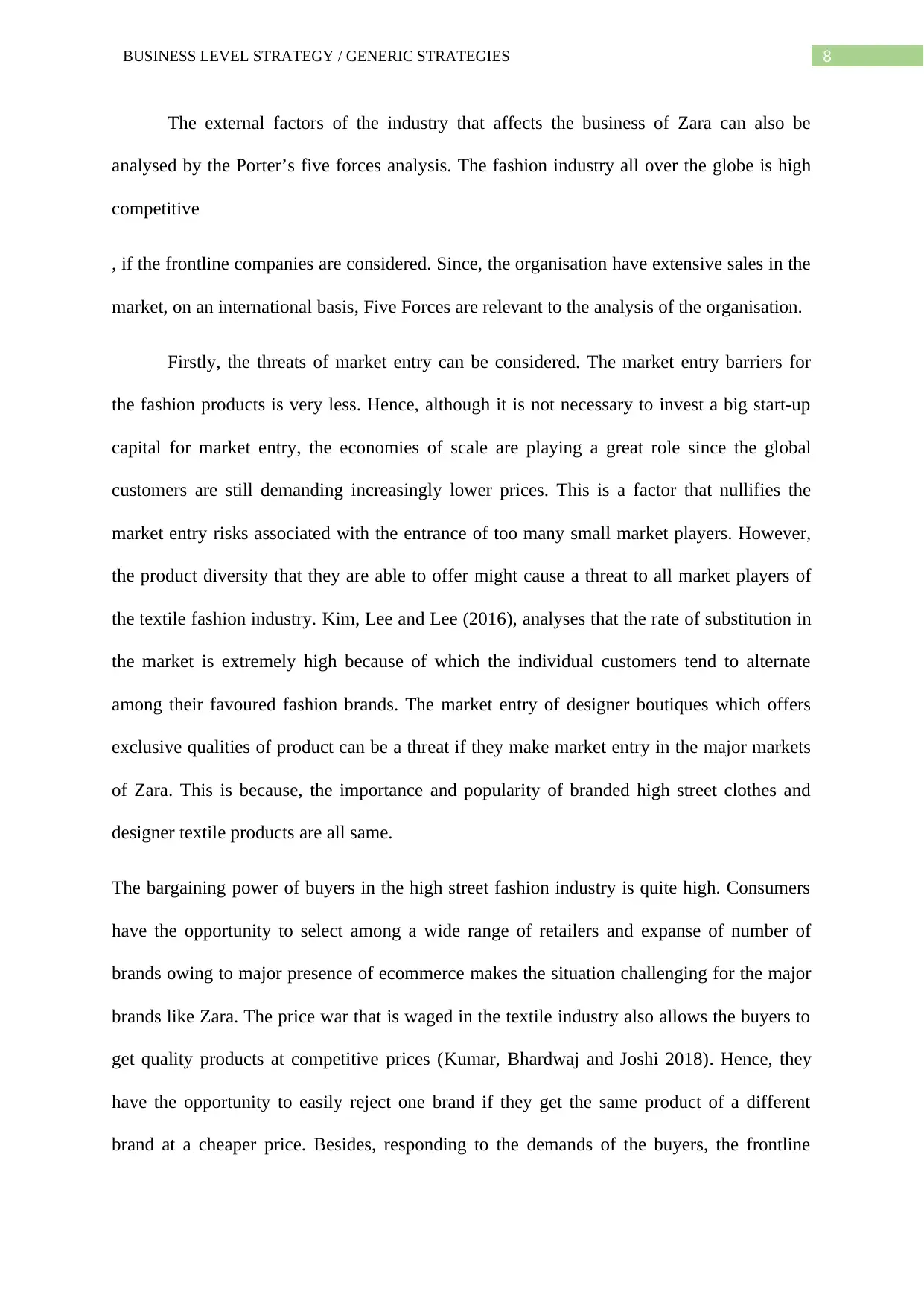
8BUSINESS LEVEL STRATEGY / GENERIC STRATEGIES
The external factors of the industry that affects the business of Zara can also be
analysed by the Porter’s five forces analysis. The fashion industry all over the globe is high
competitive
, if the frontline companies are considered. Since, the organisation have extensive sales in the
market, on an international basis, Five Forces are relevant to the analysis of the organisation.
Firstly, the threats of market entry can be considered. The market entry barriers for
the fashion products is very less. Hence, although it is not necessary to invest a big start-up
capital for market entry, the economies of scale are playing a great role since the global
customers are still demanding increasingly lower prices. This is a factor that nullifies the
market entry risks associated with the entrance of too many small market players. However,
the product diversity that they are able to offer might cause a threat to all market players of
the textile fashion industry. Kim, Lee and Lee (2016), analyses that the rate of substitution in
the market is extremely high because of which the individual customers tend to alternate
among their favoured fashion brands. The market entry of designer boutiques which offers
exclusive qualities of product can be a threat if they make market entry in the major markets
of Zara. This is because, the importance and popularity of branded high street clothes and
designer textile products are all same.
The bargaining power of buyers in the high street fashion industry is quite high. Consumers
have the opportunity to select among a wide range of retailers and expanse of number of
brands owing to major presence of ecommerce makes the situation challenging for the major
brands like Zara. The price war that is waged in the textile industry also allows the buyers to
get quality products at competitive prices (Kumar, Bhardwaj and Joshi 2018). Hence, they
have the opportunity to easily reject one brand if they get the same product of a different
brand at a cheaper price. Besides, responding to the demands of the buyers, the frontline
The external factors of the industry that affects the business of Zara can also be
analysed by the Porter’s five forces analysis. The fashion industry all over the globe is high
competitive
, if the frontline companies are considered. Since, the organisation have extensive sales in the
market, on an international basis, Five Forces are relevant to the analysis of the organisation.
Firstly, the threats of market entry can be considered. The market entry barriers for
the fashion products is very less. Hence, although it is not necessary to invest a big start-up
capital for market entry, the economies of scale are playing a great role since the global
customers are still demanding increasingly lower prices. This is a factor that nullifies the
market entry risks associated with the entrance of too many small market players. However,
the product diversity that they are able to offer might cause a threat to all market players of
the textile fashion industry. Kim, Lee and Lee (2016), analyses that the rate of substitution in
the market is extremely high because of which the individual customers tend to alternate
among their favoured fashion brands. The market entry of designer boutiques which offers
exclusive qualities of product can be a threat if they make market entry in the major markets
of Zara. This is because, the importance and popularity of branded high street clothes and
designer textile products are all same.
The bargaining power of buyers in the high street fashion industry is quite high. Consumers
have the opportunity to select among a wide range of retailers and expanse of number of
brands owing to major presence of ecommerce makes the situation challenging for the major
brands like Zara. The price war that is waged in the textile industry also allows the buyers to
get quality products at competitive prices (Kumar, Bhardwaj and Joshi 2018). Hence, they
have the opportunity to easily reject one brand if they get the same product of a different
brand at a cheaper price. Besides, responding to the demands of the buyers, the frontline
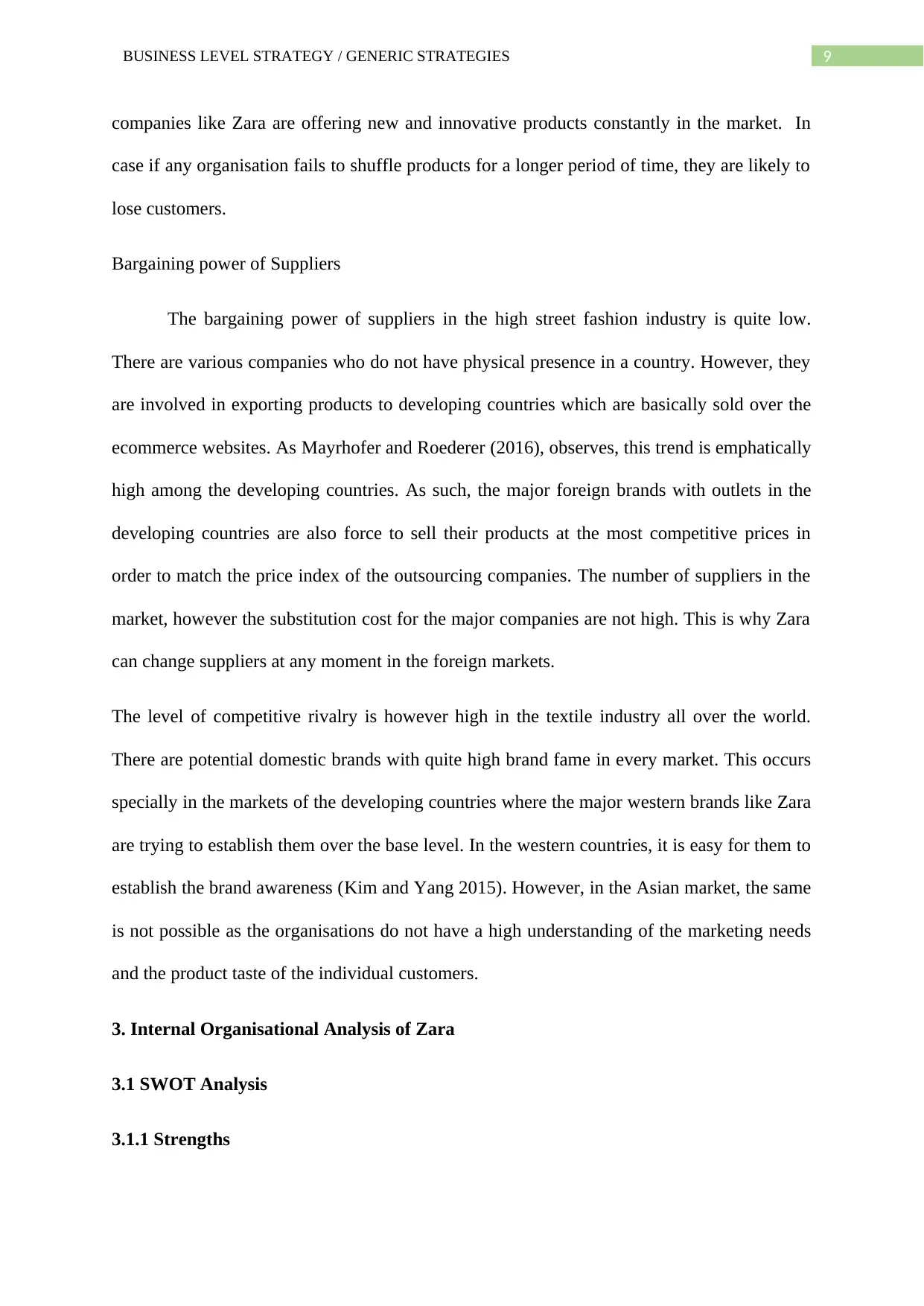
9BUSINESS LEVEL STRATEGY / GENERIC STRATEGIES
companies like Zara are offering new and innovative products constantly in the market. In
case if any organisation fails to shuffle products for a longer period of time, they are likely to
lose customers.
Bargaining power of Suppliers
The bargaining power of suppliers in the high street fashion industry is quite low.
There are various companies who do not have physical presence in a country. However, they
are involved in exporting products to developing countries which are basically sold over the
ecommerce websites. As Mayrhofer and Roederer (2016), observes, this trend is emphatically
high among the developing countries. As such, the major foreign brands with outlets in the
developing countries are also force to sell their products at the most competitive prices in
order to match the price index of the outsourcing companies. The number of suppliers in the
market, however the substitution cost for the major companies are not high. This is why Zara
can change suppliers at any moment in the foreign markets.
The level of competitive rivalry is however high in the textile industry all over the world.
There are potential domestic brands with quite high brand fame in every market. This occurs
specially in the markets of the developing countries where the major western brands like Zara
are trying to establish them over the base level. In the western countries, it is easy for them to
establish the brand awareness (Kim and Yang 2015). However, in the Asian market, the same
is not possible as the organisations do not have a high understanding of the marketing needs
and the product taste of the individual customers.
3. Internal Organisational Analysis of Zara
3.1 SWOT Analysis
3.1.1 Strengths
companies like Zara are offering new and innovative products constantly in the market. In
case if any organisation fails to shuffle products for a longer period of time, they are likely to
lose customers.
Bargaining power of Suppliers
The bargaining power of suppliers in the high street fashion industry is quite low.
There are various companies who do not have physical presence in a country. However, they
are involved in exporting products to developing countries which are basically sold over the
ecommerce websites. As Mayrhofer and Roederer (2016), observes, this trend is emphatically
high among the developing countries. As such, the major foreign brands with outlets in the
developing countries are also force to sell their products at the most competitive prices in
order to match the price index of the outsourcing companies. The number of suppliers in the
market, however the substitution cost for the major companies are not high. This is why Zara
can change suppliers at any moment in the foreign markets.
The level of competitive rivalry is however high in the textile industry all over the world.
There are potential domestic brands with quite high brand fame in every market. This occurs
specially in the markets of the developing countries where the major western brands like Zara
are trying to establish them over the base level. In the western countries, it is easy for them to
establish the brand awareness (Kim and Yang 2015). However, in the Asian market, the same
is not possible as the organisations do not have a high understanding of the marketing needs
and the product taste of the individual customers.
3. Internal Organisational Analysis of Zara
3.1 SWOT Analysis
3.1.1 Strengths
⊘ This is a preview!⊘
Do you want full access?
Subscribe today to unlock all pages.

Trusted by 1+ million students worldwide
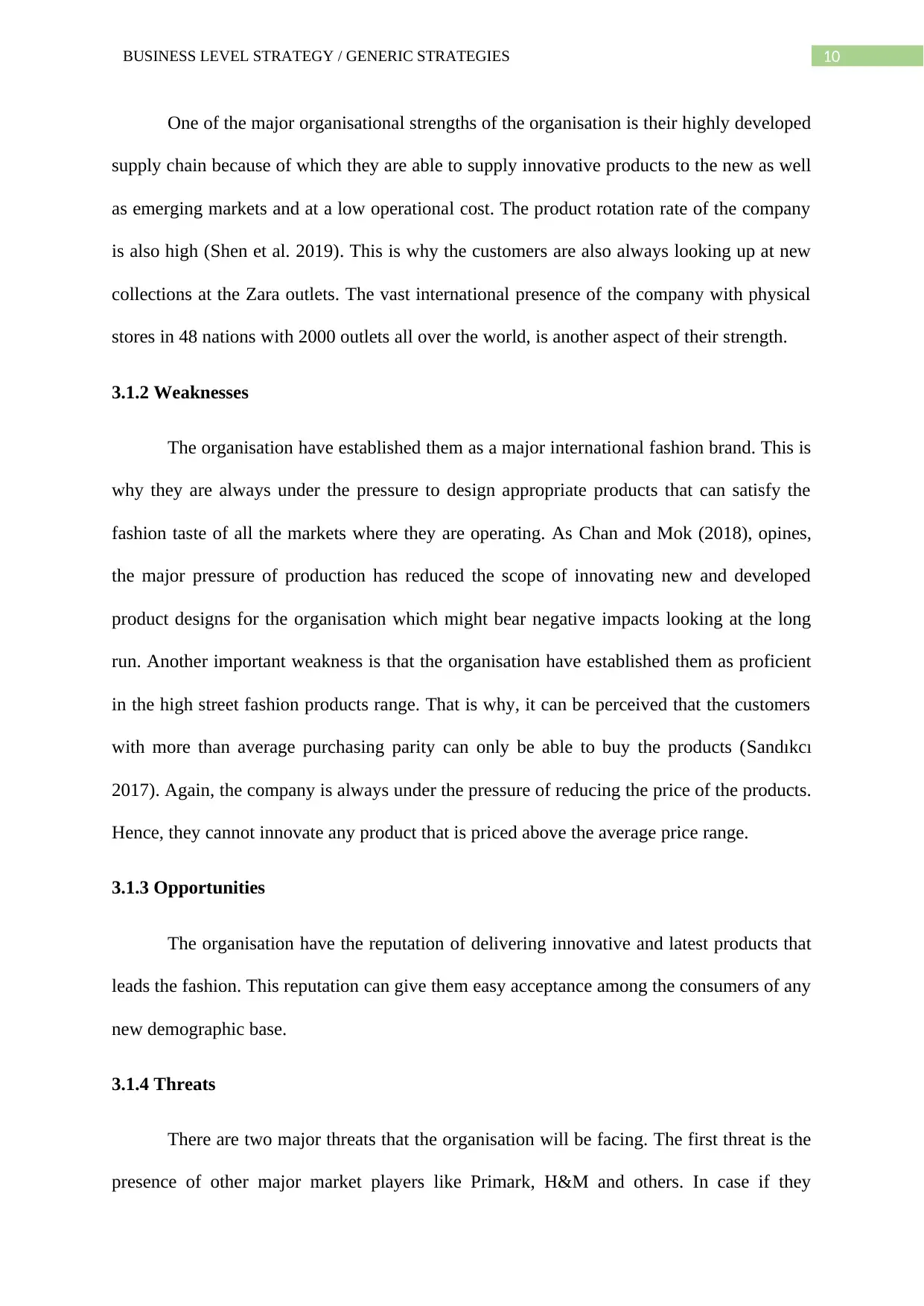
10BUSINESS LEVEL STRATEGY / GENERIC STRATEGIES
One of the major organisational strengths of the organisation is their highly developed
supply chain because of which they are able to supply innovative products to the new as well
as emerging markets and at a low operational cost. The product rotation rate of the company
is also high (Shen et al. 2019). This is why the customers are also always looking up at new
collections at the Zara outlets. The vast international presence of the company with physical
stores in 48 nations with 2000 outlets all over the world, is another aspect of their strength.
3.1.2 Weaknesses
The organisation have established them as a major international fashion brand. This is
why they are always under the pressure to design appropriate products that can satisfy the
fashion taste of all the markets where they are operating. As Chan and Mok (2018), opines,
the major pressure of production has reduced the scope of innovating new and developed
product designs for the organisation which might bear negative impacts looking at the long
run. Another important weakness is that the organisation have established them as proficient
in the high street fashion products range. That is why, it can be perceived that the customers
with more than average purchasing parity can only be able to buy the products (Sandıkcı
2017). Again, the company is always under the pressure of reducing the price of the products.
Hence, they cannot innovate any product that is priced above the average price range.
3.1.3 Opportunities
The organisation have the reputation of delivering innovative and latest products that
leads the fashion. This reputation can give them easy acceptance among the consumers of any
new demographic base.
3.1.4 Threats
There are two major threats that the organisation will be facing. The first threat is the
presence of other major market players like Primark, H&M and others. In case if they
One of the major organisational strengths of the organisation is their highly developed
supply chain because of which they are able to supply innovative products to the new as well
as emerging markets and at a low operational cost. The product rotation rate of the company
is also high (Shen et al. 2019). This is why the customers are also always looking up at new
collections at the Zara outlets. The vast international presence of the company with physical
stores in 48 nations with 2000 outlets all over the world, is another aspect of their strength.
3.1.2 Weaknesses
The organisation have established them as a major international fashion brand. This is
why they are always under the pressure to design appropriate products that can satisfy the
fashion taste of all the markets where they are operating. As Chan and Mok (2018), opines,
the major pressure of production has reduced the scope of innovating new and developed
product designs for the organisation which might bear negative impacts looking at the long
run. Another important weakness is that the organisation have established them as proficient
in the high street fashion products range. That is why, it can be perceived that the customers
with more than average purchasing parity can only be able to buy the products (Sandıkcı
2017). Again, the company is always under the pressure of reducing the price of the products.
Hence, they cannot innovate any product that is priced above the average price range.
3.1.3 Opportunities
The organisation have the reputation of delivering innovative and latest products that
leads the fashion. This reputation can give them easy acceptance among the consumers of any
new demographic base.
3.1.4 Threats
There are two major threats that the organisation will be facing. The first threat is the
presence of other major market players like Primark, H&M and others. In case if they
Paraphrase This Document
Need a fresh take? Get an instant paraphrase of this document with our AI Paraphraser
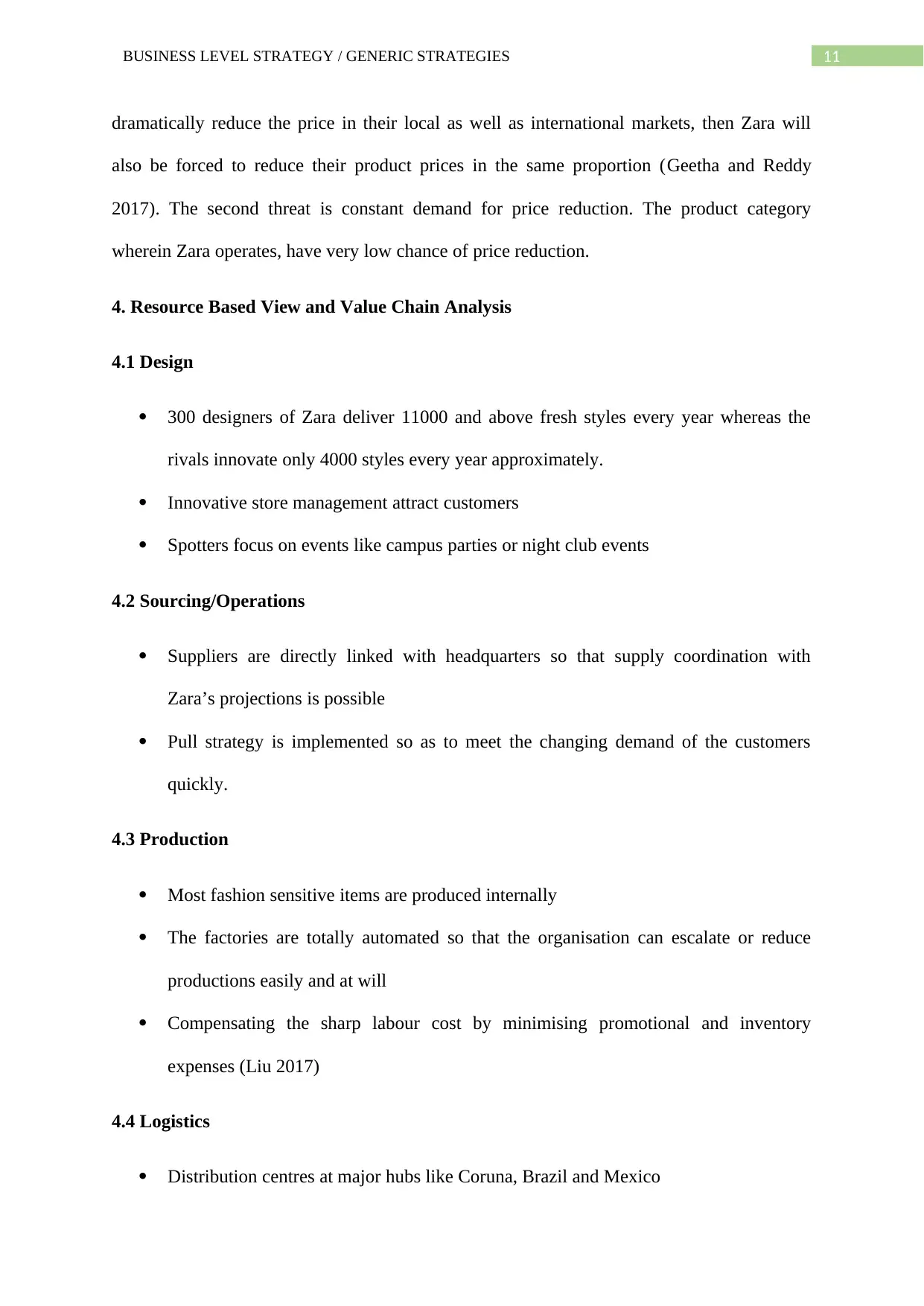
11BUSINESS LEVEL STRATEGY / GENERIC STRATEGIES
dramatically reduce the price in their local as well as international markets, then Zara will
also be forced to reduce their product prices in the same proportion (Geetha and Reddy
2017). The second threat is constant demand for price reduction. The product category
wherein Zara operates, have very low chance of price reduction.
4. Resource Based View and Value Chain Analysis
4.1 Design
300 designers of Zara deliver 11000 and above fresh styles every year whereas the
rivals innovate only 4000 styles every year approximately.
Innovative store management attract customers
Spotters focus on events like campus parties or night club events
4.2 Sourcing/Operations
Suppliers are directly linked with headquarters so that supply coordination with
Zara’s projections is possible
Pull strategy is implemented so as to meet the changing demand of the customers
quickly.
4.3 Production
Most fashion sensitive items are produced internally
The factories are totally automated so that the organisation can escalate or reduce
productions easily and at will
Compensating the sharp labour cost by minimising promotional and inventory
expenses (Liu 2017)
4.4 Logistics
Distribution centres at major hubs like Coruna, Brazil and Mexico
dramatically reduce the price in their local as well as international markets, then Zara will
also be forced to reduce their product prices in the same proportion (Geetha and Reddy
2017). The second threat is constant demand for price reduction. The product category
wherein Zara operates, have very low chance of price reduction.
4. Resource Based View and Value Chain Analysis
4.1 Design
300 designers of Zara deliver 11000 and above fresh styles every year whereas the
rivals innovate only 4000 styles every year approximately.
Innovative store management attract customers
Spotters focus on events like campus parties or night club events
4.2 Sourcing/Operations
Suppliers are directly linked with headquarters so that supply coordination with
Zara’s projections is possible
Pull strategy is implemented so as to meet the changing demand of the customers
quickly.
4.3 Production
Most fashion sensitive items are produced internally
The factories are totally automated so that the organisation can escalate or reduce
productions easily and at will
Compensating the sharp labour cost by minimising promotional and inventory
expenses (Liu 2017)
4.4 Logistics
Distribution centres at major hubs like Coruna, Brazil and Mexico
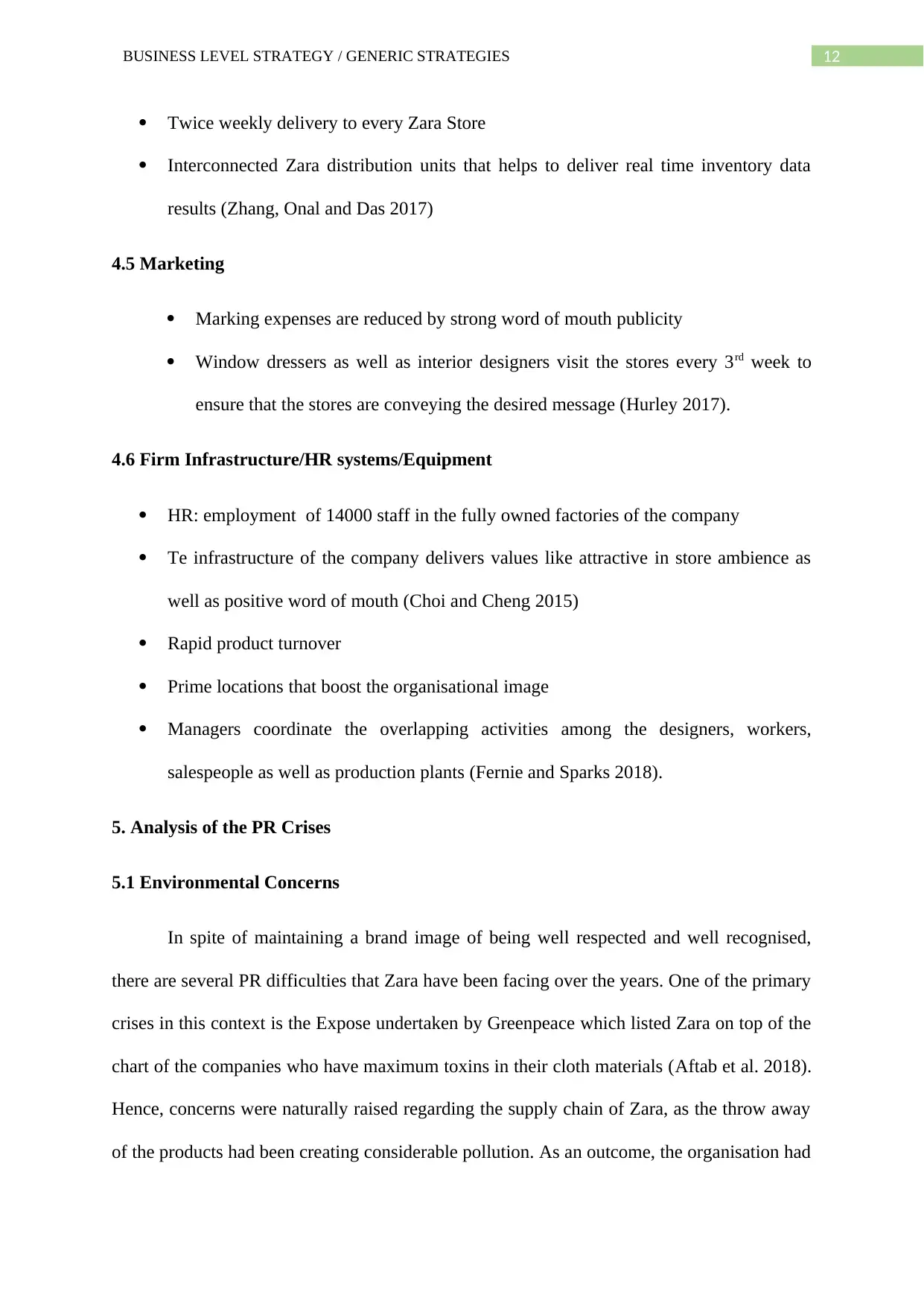
12BUSINESS LEVEL STRATEGY / GENERIC STRATEGIES
Twice weekly delivery to every Zara Store
Interconnected Zara distribution units that helps to deliver real time inventory data
results (Zhang, Onal and Das 2017)
4.5 Marketing
Marking expenses are reduced by strong word of mouth publicity
Window dressers as well as interior designers visit the stores every 3rd week to
ensure that the stores are conveying the desired message (Hurley 2017).
4.6 Firm Infrastructure/HR systems/Equipment
HR: employment of 14000 staff in the fully owned factories of the company
Te infrastructure of the company delivers values like attractive in store ambience as
well as positive word of mouth (Choi and Cheng 2015)
Rapid product turnover
Prime locations that boost the organisational image
Managers coordinate the overlapping activities among the designers, workers,
salespeople as well as production plants (Fernie and Sparks 2018).
5. Analysis of the PR Crises
5.1 Environmental Concerns
In spite of maintaining a brand image of being well respected and well recognised,
there are several PR difficulties that Zara have been facing over the years. One of the primary
crises in this context is the Expose undertaken by Greenpeace which listed Zara on top of the
chart of the companies who have maximum toxins in their cloth materials (Aftab et al. 2018).
Hence, concerns were naturally raised regarding the supply chain of Zara, as the throw away
of the products had been creating considerable pollution. As an outcome, the organisation had
Twice weekly delivery to every Zara Store
Interconnected Zara distribution units that helps to deliver real time inventory data
results (Zhang, Onal and Das 2017)
4.5 Marketing
Marking expenses are reduced by strong word of mouth publicity
Window dressers as well as interior designers visit the stores every 3rd week to
ensure that the stores are conveying the desired message (Hurley 2017).
4.6 Firm Infrastructure/HR systems/Equipment
HR: employment of 14000 staff in the fully owned factories of the company
Te infrastructure of the company delivers values like attractive in store ambience as
well as positive word of mouth (Choi and Cheng 2015)
Rapid product turnover
Prime locations that boost the organisational image
Managers coordinate the overlapping activities among the designers, workers,
salespeople as well as production plants (Fernie and Sparks 2018).
5. Analysis of the PR Crises
5.1 Environmental Concerns
In spite of maintaining a brand image of being well respected and well recognised,
there are several PR difficulties that Zara have been facing over the years. One of the primary
crises in this context is the Expose undertaken by Greenpeace which listed Zara on top of the
chart of the companies who have maximum toxins in their cloth materials (Aftab et al. 2018).
Hence, concerns were naturally raised regarding the supply chain of Zara, as the throw away
of the products had been creating considerable pollution. As an outcome, the organisation had
⊘ This is a preview!⊘
Do you want full access?
Subscribe today to unlock all pages.

Trusted by 1+ million students worldwide
1 out of 18
Related Documents
Your All-in-One AI-Powered Toolkit for Academic Success.
+13062052269
info@desklib.com
Available 24*7 on WhatsApp / Email
![[object Object]](/_next/static/media/star-bottom.7253800d.svg)
Unlock your academic potential
Copyright © 2020–2025 A2Z Services. All Rights Reserved. Developed and managed by ZUCOL.





